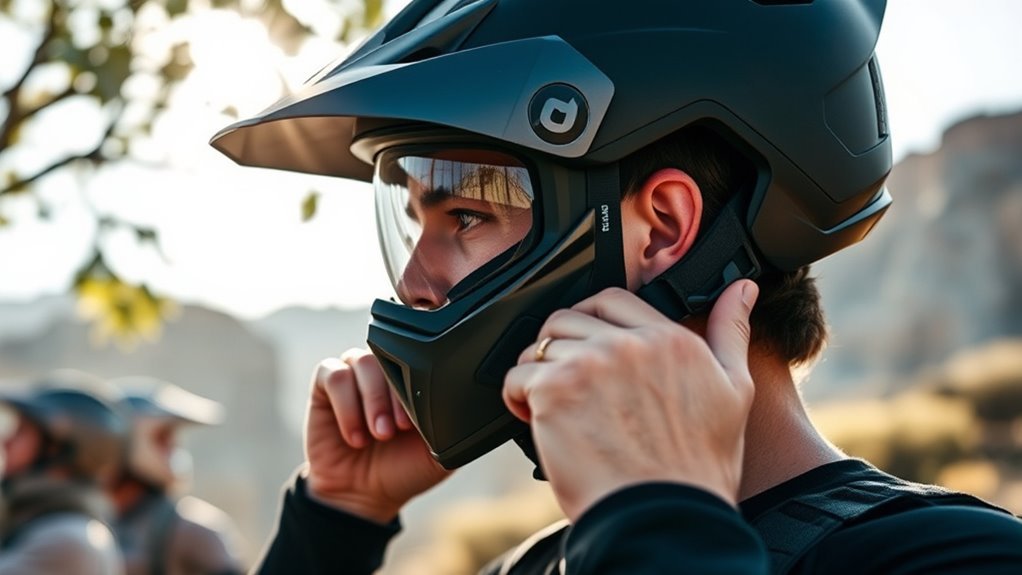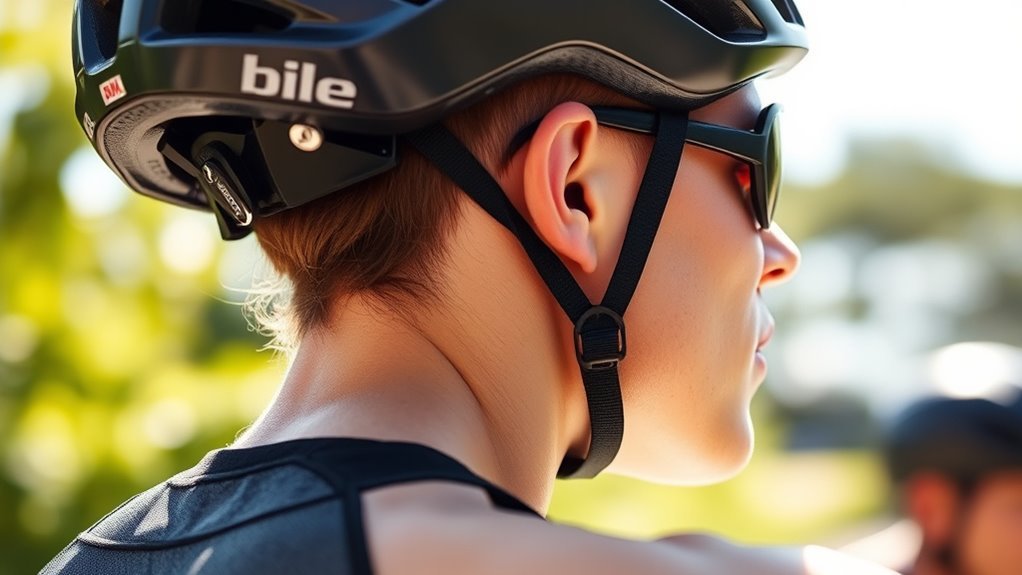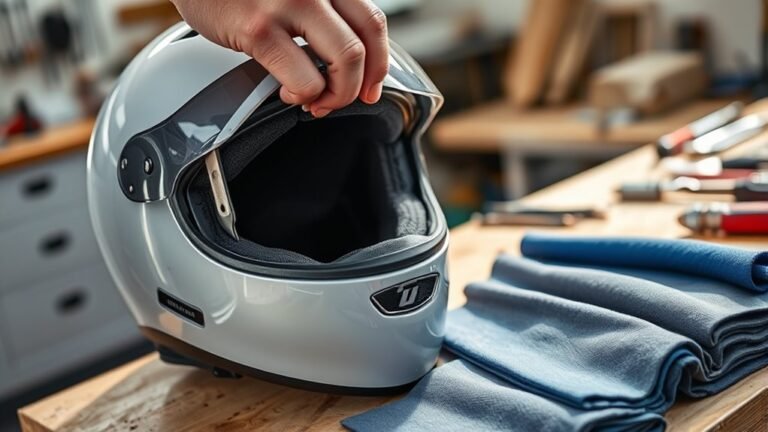Preventing Neck Pain From Heavy Helmets
To prevent neck pain from heavy helmets, choose lightweight options with proper weight distribution. Guarantee a snug fit to avoid sliding or discomfort. Strengthening your neck muscles through targeted exercises is vital for improved endurance. While wearing a helmet, take breaks to relieve tension and gradually increase your wear time for muscle adaptation. Utilizing additional padding can also enhance comfort. For more effective strategies, consider exploring further tips and insights.
Understanding the Impact of Helmet Weight on Neck Health

As you might have experienced, the weight of a helmet can considerably affect your neck health over time. Poor helmet design often leads to uneven weight distribution, which can strain your neck muscles and contribute to pain. Research shows that heavier helmets can increase the risk of developing chronic neck issues, especially during prolonged wear. Proper weight distribution is vital; it helps minimize the burden on your neck, allowing for greater freedom of movement and reducing fatigue. When selecting a helmet, it’s essential to take into account not only its weight but also how its design supports balanced weight distribution. This can make a significant difference in your overall comfort and health, enabling you to enjoy activities without the worry of neck pain.
Choosing the Right Helmet for Comfort and Support

Finding the right helmet is essential for guaranteeing comfort and support during your activities. A helmet made from lightweight materials can greatly reduce the strain on your neck, allowing you to enjoy longer sessions without discomfort. Look for options that feature adjustable features, such as straps and padding, to customize the fit according to your preferences. This not only enhances comfort but also provides better support, helping to distribute weight evenly across your head. Remember, a well-fitted helmet reduces the risk of injury while promoting freedom of movement. Prioritizing these characteristics guarantees that your helmet won’t hinder your performance, allowing you to focus on your activities instead of discomfort. Choose wisely, and enjoy your adventures!
Proper Helmet Fit: Ensuring Stability Without Strain

While you might think that any helmet will do, achieving proper fit is essential for both safety and comfort. A helmet that’s too loose can slide around, while one that’s too tight may cause discomfort or even headaches. Start by measuring your head to determine the correct helmet size. Use adjustment techniques such as the retention system and pads to guarantee a snug fit without pressure points. Make sure the helmet sits level on your head, covering your forehead without obstructing your vision. When secured, it shouldn’t move when you shake your head. A well-fitted helmet enhances stability and minimizes strain on your neck, allowing you to enjoy your activities with freedom and confidence.
Strengthening Neck Muscles to Combat Fatigue
To effectively combat fatigue caused by heavy helmets, strengthening your neck muscles is essential. Incorporating neck exercises into your routine can greatly improve muscle endurance and enhance your overall comfort. Here’s a simple table with effective neck exercises to take into account:
| Exercise | Duration/Reps |
|---|---|
| Neck Flexion | 3 sets of 10 reps |
| Neck Extension | 3 sets of 10 reps |
| Lateral Neck Flexion | 3 sets of 10 reps (each side) |
| Neck Rotations | 3 sets of 10 reps |
These exercises target various neck muscles, helping to build strength and reduce fatigue. By committing to these neck exercises regularly, you’ll support your neck’s stability and resilience against the strain of heavy helmets. Prioritize your freedom from discomfort by making this commitment today!
Tips for Adjusting to Heavy Helmets During Use
Adjusting to wearing heavy helmets can be challenging, but employing a few practical tips can make the experience more manageable. Start with proper helmet positioning; guarantee it sits level on your head and snugly fits your chin strap. This can distribute weight evenly, reducing strain on your neck. Utilize adjustment techniques like taking frequent breaks to relieve tension. Gradually increase your wear time, allowing your neck muscles to adapt. Consider using additional padding for comfort, which can also help with stability. Finally, perform gentle neck stretches during breaks to enhance flexibility and reduce discomfort. By implementing these strategies, you’ll find that wearing heavy helmets becomes less taxing, allowing you to focus on your activities without compromising your freedom.
Frequently Asked Questions
How Often Should I Take Breaks While Wearing a Heavy Helmet?
You should take breaks every 30 to 60 minutes while wearing a heavy helmet. During these breaks, aim for a duration of about 5 to 10 minutes to relieve neck strain. It’s also crucial to make helmet adjustments to guarantee a proper fit, minimizing pressure on your neck. Regular breaks and proper adjustments can greatly enhance your comfort and reduce the risk of discomfort, allowing you to enjoy your activities more freely.
Are There Specific Exercises to Relieve Neck Pain From Helmets?
Oh sure, just wear that heavy helmet all day and hope your neck becomes Hercules! But seriously, incorporating neck strengthening exercises, like gentle rotations and isometric holds, can really help. You might also want to check those helmet adjustments—too tight or too loose can lead to unnecessary strain. A balanced approach of strengthening and proper fit can keep you free from discomfort while still looking like a warrior on the field!
Can Helmet Accessories Increase Neck Strain?
Yes, helmet accessories can increase neck strain. Poor helmet design or inadequate padding materials can add unnecessary weight or pressure points, leading to discomfort. If accessories like visors or communication devices are too heavy or improperly positioned, they can throw off your balance and strain your neck muscles. It’s essential to choose helmets with lightweight designs and high-quality padding to minimize these risks, ensuring you stay comfortable and free while wearing your gear.
What Should I Do if My Helmet Causes Headaches?
If your helmet’s causing headaches, think of it as a tight hat squeezing your brain. First, try making helmet adjustments; make certain it’s not too tight and sits properly. Next, consider headache remedies like hydration, over-the-counter pain relief, or a short break. If the problem persists, consult a professional. Remember, your comfort and freedom to enjoy activities shouldn’t come at the cost of pain—find the right fit for your helmet.
Is There a Weight Limit for Safe Helmet Usage?
There isn’t a specific weight limit for safe helmet usage, but most safety standards recommend that helmets be as lightweight as possible while still offering adequate protection. Generally, a helmet should weigh between 1.5 to 3 pounds, depending on its intended use. It’s essential to choose a helmet that balances comfort, weight, and safety features, ensuring it doesn’t strain your neck or cause discomfort during prolonged wear. Always check for compliance with relevant safety standards.






